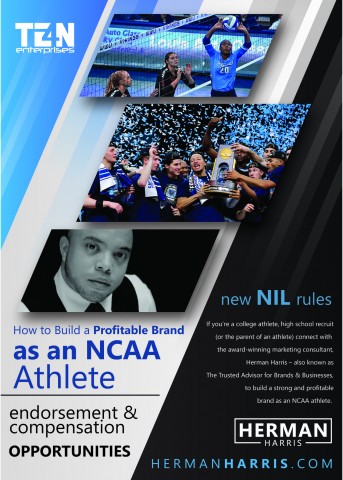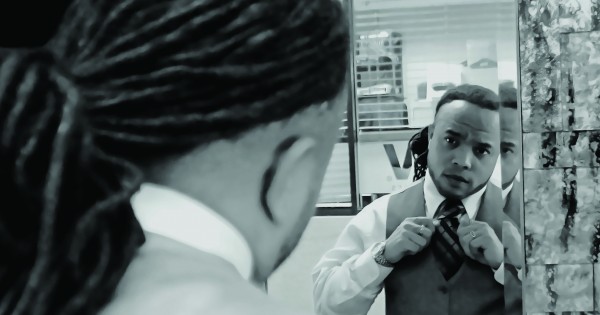Award-winning consultant Herman Harris – founder of TEN 4 Enterprises, shares exclusive marketing insight for college athletes wanting to know how to build a profitable brand and make money using their name and celebrity.
The biggest rule change in the history of college athletics has graced the NCAA. The NCAA will now allow its athletes to profit off their own personas, known as “NIL” (Name, Image, and Likeness) — which is something college athletes haven’t been permitted to do in the past. In short, the new policy provides innovative opportunities on how collegiate athletes, at every level, may monetize their brand by receiving endorsements and compensation.
This is an incredibly big deal because collegiate athletes will no longer have major restrictions looming above their heads on how they can be compensated for their NIL. Previously, athletes could be suspended or lose eligibility if they were found in violation of the former rules.

What Were the Old Rules Exactly?
Athletes were prohibited by the NCAA from accepting any outside money. They imposed this regulation to preserve “amateurism,” the concept that college athletes are not professionals and therefore did not need to be compensated. The governing bodies and decision-makers of the NCAA had believed that providing scholarships and stipends to athletes was sufficient. Not any more…
Moving Forward…
Now that NCAA athletes have the permission to cash in on their respective brands, many athletes may be wondering where to start to create their brands while others may be more concerned about growing their existing brands.
If you’re a college athlete, high school recruit or the parent of an athlete the following information from the award-winning marketing consultant, Herman Harris – also known as The Trusted Advisor for Brands & Businesses, is imperative to building a profitable brand as an NCAA athlete.

In order to gain the highest financial return for their NIL an athlete must first establish, build and cultivate their personal brand to the highest level. Some athletes will have advantages that others do not which may yield them a greater financial return on their Name, Image and Likeness. Examples of those advantages include but are not limited to star-power, name (brand) awareness, school authority, popularity, and/or a very large social media following.
In order to compete with the athletes that have a clear advantage (in most cases rightfully so) regarding financial gain from their NIL other athletes need to begin developing a winning personal brand immediately. On the other hand, for athletes that have an advantage within the new landscape of NIL, there are still plenty of opportunities to further capitalize on what the NCAA has been doing with your brand since the inception of the association.

The Top Two Most Asked Questions Among High School Recruits and College Athletes: (since NIL rule change)
1) How do I begin building my brand as an NCAA athlete?
2) How do I make more money with my brand from my NIL (Name, Image, and Likeness)?
To answer those questions let’s start with the fundamentals of a personal brand – the driving force behind an athlete’s NIL and what the NCAA is now allowing their athletes to make money from ultimately.
What is a Personal Brand?
A personal brand precisely communicates an individual’s values, beliefs, goals, and purpose. This carefully crafted and intentional communication establishes the public persona for a target audience. For reference, we can take a look at one of the biggest brands exposed to athletes – NIKE. The leader in athletic apparel has built a brand around celebrating athletes of all ages and backgrounds, high-performance gear and products, and promoting a competitive and active lifestyle.
We see examples of NIKE’s branding virtually everywhere, from advertisements on television to college locker rooms and from social media platforms to event venues. When developing your brand as an athlete you want to appear in as many places as possible within your niche. Many athletes will naturally focus on capitalizing off their NIL primarily through social media but, business strategist and Principal Consultant of TEN 4 Enterprises – Herman Harris says, it’s critical for NCAA athletes to develop their brands beyond social media and incorporate offline mediums to maximize exposure and revenue in relation to their brand.
Why Should You Build a Personal Brand?
In essence, personal brands exist in some capacity whether or not you create it for yourself. Your brand is developed around the content you share on social media, post and pre-game interviews, highlight reels of your athletic performance, your personality, blogs and articles discussing your accomplishments, as well as social events you attend and many other avenues.
Athletes need to be consistently and actively building their own personal brand in order to have control over it. As a valuable by-product, athletes aren’t subjected to the vulnerability of assumptions people form about what their brand represents. Additionally, athletes can then leverage their Name, Image and Likeness based on how they have developed their own personal brands for maximum value – (and maximum dollars). Athletes investing into their future through their athletic talents need to be able to control the narrative about what their audience sees and how they see it. The return on your financial and business goals can be very rewarding as a result.
What Are the Best Personal Branding Strategies?
Athletes are conditioned to be in the limelight. Star-power athletes typically find themselves under the microscope of the limelight whether they want to be there or not. As an athlete begins to grow their personal brand, one of the key elements that keep profitability high is executing the best strategies to mature their brand and avoid costly drawbacks. An athlete’s reputation precedes a lot of opportunities including financial rewards.
Your brand, in respect of the new NIL rule, is more important than ever as a college athlete. It’s important for all NCAA athletes to understand that they will NOT be able to use their university’s logo when promoting and advertising their personal brand in exchange for money. For example, a Sam Houston State wide-receiver may host a paid football camp for high school students but they will not be able to use Bearkat trademarks throughout the endeavor – including wearing SHSU logos on their clothes etc. In other words, athletes cannot leverage their university to make money; they must use their own Name, Image and Likeness instead.
The following are tips and strategies to help develop a profitable brand as an NCAA athlete:

Identify Your Goals
Begin documenting your projected goals by writing down where you would like to be six months (or a season) from now. Follow up with one year projections; and three, five and ten year goal projections.
Identify Your Specific Target Market & Audience
Define the audience your messaging and communications are specifically designed to reach. Create target goals and segment them as milestones along your brand building journey. Once defined, develop a sequence of action plans to pursue each market accordingly.
Determine Your Unique Value (Selling) Proposition [USP]
Determine what separates you from other athletes; including your teammates. It’s perfectly fine to share similarities with others, especially those you share a bond with, however it’s equally important to establish what differentiates you from the crowd. Perhaps it’s a specific strength? Maybe it’s something you’re passionate about? It can even be a unique life experience.
Focus on the Details
It may not seem like it, but as a collegiate athlete under the limelight of competition and athletic entertainment everything you do ultimately contributes to your personal brand. The smallest details can have the most rewarding impact (as well as the contrary if you’re not careful). As you leverage your NIL to secure more sponsorship deals, things that may have been previously overlooked as contributors to your brand now affect it – from your style of fashion, hobbies, views and values, body language, and more.
Identify Your Strengths and Weaknesses
Embracing weaknesses is usually the most difficult for athletes. Between the nature of competition and fan observance, there’s an expectation of strength that seemingly needs to be validated. However, it’s perfectly fine to embrace your weaknesses; in fact, athletes should strategically communicate their weaknesses to their audiences. This resonates with fans and spectators watching your athletic talents; making you appear as human as them. It’s also just as important to own your strengths. Frequently, athletes find themselves as role models and mentors by proxy as a result of their strengths. Whether it’s a fan in the student section of a stadium or a kid aspiring to be as athletically gifted as their collegiate hero, strengths are virtuous to a profitable brand.
Double Down on Networking
Building a profitable brand as an athlete means becoming very visible to your target audience and potential sponsorship and endorsement partners. It is very important to extend your networking interactions beyond the online realm. Athletes should be attending networking events and becoming active within their community. Get involved as early as possible through both informal and formal events. The more visible you are as an athlete, the stronger your brand, the more potential partners are willing to invest into you.
Always remember that networking is a two-way street. Yes, you should be marketing yourself as an athlete to potential partners however you must also allow the opportunity for others to market themselves to you too. Cultivate those business relationships and maximize mutual earning potential.
Stay Abreast of Current Events
Stay up to date with the current events within your niche or sport, locally and nationally. As an athlete, you want to be in a position to strategically involve (or exclude) yourself in situations or circumstances inclusive of your audience. Perhaps it’s a charitable cause in your local community or an athlete-related situation within your sport. Be adequately prepared to handle each scenario accordingly.
Grow Your Online Presence
With access to social media at everyone’s fingertips, it’s important for college athletes to build social profiles across several platforms. You want your audience to be able to find you and engage with you on the platforms that they use often. Your preferred choice may be Instagram for example, but you also want to be able to engage the audience that chooses to use Facebook as their preferred social media platform.
Another reason it’s important for athletes to grow their online presence is because potential partners and sponsors will be more inclined to create deals with athletes who have more visibility in the online space. More visibility means more reach, and more reach means more opportunities for earning potential.
Build a Website for Your Brand
If you want to create a strong personal brand, you need to have a website. Athletes need to have a centralized location on the internet that isn’t a social media profile. Your website will function as the hub for your Name, Image and Likeness. From your website you can sell digital products, merchandise, and access to various events. Your website will also function as the primary source to showcase your athletic and lifestyle journey.
Additionally, athletes should own the domain of their name. This can be challenging for a few reasons so it’s best to act as quickly as possible when it comes to buying a domain of your name. If you share a common name with other people there may be a chance someone already owns your name’s domain. If so, get creative but remain unique and relevant in choosing your domain. The sooner you obtain your domain – the better; so if you’re a high school athlete or the parent of an athlete please purchase your domains now. If you’re a current college athlete and you don’t own your domain yet, act as swiftly as possible even if you do not have a website built yet. Own the domain. Your brand will benefit greatly as a result.

How can College Athletes Monetize Their NIL?
It’s vital for all athletes that want to capitalize on their NIL financially to take control over their brand narrative. Building a personal brand as an athlete doesn’t happen overnight nor is it something that should be left to chance.
NCAA athletes and high school recruits should implement the tips and strategies above to get started on building their personal brand. Utilize social media, leverage your network, own your website and domain, share valuable and insightful information with your audience and always have a purpose for doing so. The more consistent you are with your messaging and communication as an athlete the more marketable you become as an athlete.
Examples of ways a college athlete can earn money from their NIL include:
1. Training Lessons
2. Athletic Camps
3. Autograph Signings
4. Merchandise Sales
5. Product/Service Endorsements
6. Sponsored Social Media Posts or Advertisements
7. Sponsored Videos on YouTube
and more…
If you are a college athlete (or the parent of a high school athlete) and would like to hire a professional to assist in the development of your personal brand you may contact Herman Harris of TEN 4 Enterprises, an expert marketing consultant, for more information. More details may be found on his website. Thousands of dollars, and potentially millions, are at stake with the new NIL rules for NCAA athletes. You do not have to venture into this new world of strategic brand marketing on your own. Connect with a professional to advise you how to position yourself for the maximum financial return during your short but meaningful collegiate career.
Media Contact
Company Name: TEN 4 Enterprises
Contact Person: Herman Harris
Email: Send Email
Phone: 281-624-5595
Address:2800 Post Oak Blvd
City: Houston
State: TX 77056
Country: United States
Website: www.ten4enterprises.com


